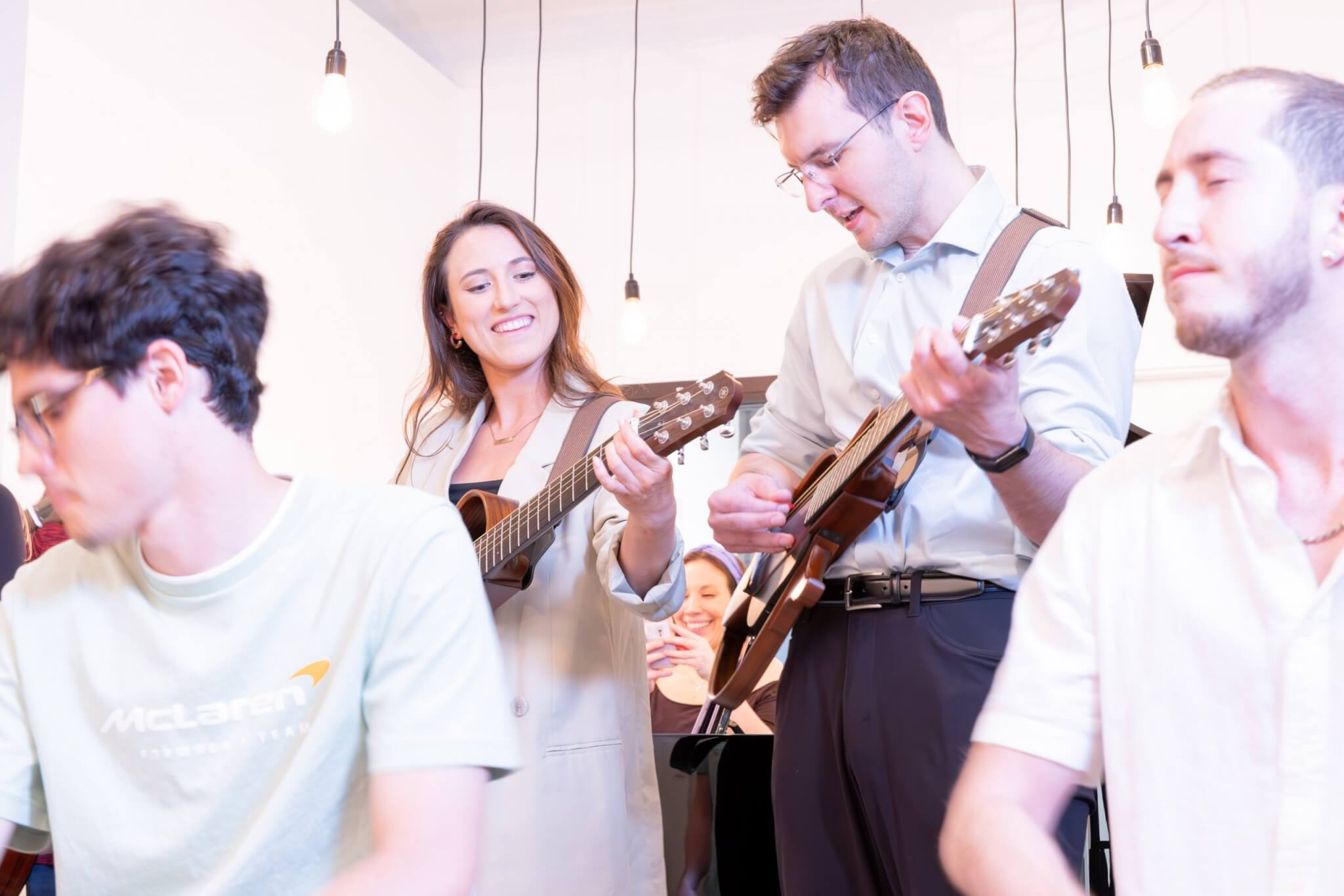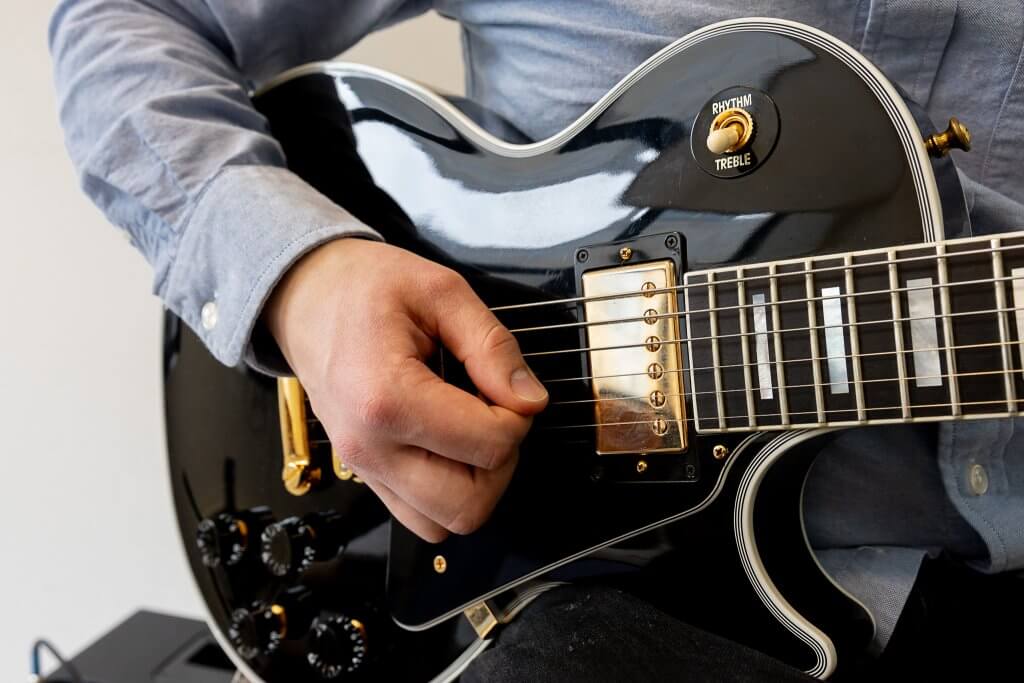Blog
Power Chords for Adult Guitar Beginners

When starting your guitar journey, especially as an adult, learning chords can feel overwhelming. One of the best ways to dive into playing your favorite rock, punk, or metal songs is by mastering power chords. These chords are simple, versatile, and found in countless iconic tracks, making them perfect for beginners. In this article, we’ll break down everything you need to know about power chords and how to incorporate them into your playing and your adult guitar lessons.
What Are Power Chords?
A power chord is a type of chord consisting of just two notes: the root and the fifth. Technically, this makes it neither major nor minor, giving it a neutral sound. Power chords are written as “5” chords (e.g., C5, G5) and are often used with distortion for a full, punchy sound. They’re especially popular in rock and metal genres, making them essential for anyone looking to play these styles on the guitar.
Why Are Power Chords Great for Adult Beginners?
As an adult beginner, you may be balancing learning guitar with other responsibilities like work, family, and life. Power chords offer a quick way to start playing songs without getting bogged down by music theory. Here’s why they are ideal for adult learners:
- Easy to Learn: Power chords are made up of just two notes and can be played using one shape across the fretboard.
- Versatile: Once you learn the basic shape, you can play it anywhere on the guitar neck.
- Great for Playing Rock and Metal: Most rock and punk songs heavily rely on power chords, so you can start jamming quickly.
- No Need for Full Chord Mastery: If you struggle with open chords or barre chords, power chords give you an alternative to start playing songs right away.

How to Play Power Chords: Step-by-Step Guide
- Basic Shape The most common power chord shape starts on the sixth string (the low E string). Here’s how to form it:
- Place your index finger on the root note of the chord (e.g., for a G5 chord, put your index finger on the 3rd fret of the 6th string).
- Place your ring finger on the 5th string, two frets higher than the root note (e.g., 5th fret for G5).
- Optionally, you can use your pinky finger to press down on the 4th string, which will double the 5th note for a fuller sound.
- Example Power Chords
- E5 Power Chord:
Index on the 7th fret (6th string), ring on the 9th fret (5th string). - A5 Power Chord:
Index on the 5th fret (6th string), ring on the 7th fret (5th string).
- E5 Power Chord:
- Practice Moving Power Chords Start by practicing simple movements between power chords, such as:
- Moving from G5 to C5.
- Shifting between E5 and A5.

Common Power Chord Songs to Practice
Once you’re comfortable with the power chord shape, try playing these easy songs to get a feel for how power chords work in real music.
- Smells Like Teen Spirit – Nirvana
This iconic track is packed with power chords. Start with the verse progression and work your way through the chorus. - Iron Man – Black Sabbath
Another classic rock song that leans heavily on power chords. Focus on the intro riff to get a feel for how power chords drive the song’s energy. - Blitzkrieg Bop – The Ramones
A fast-paced punk anthem that relies almost entirely on power chords. It’s great for practicing transitions.
Power Chords and Guitar Technique for Adult Guitar lessons
As an adult guitar learner, building good technique can make your practice more efficient and less frustrating. Here are a few key tips to keep in mind:
- Finger Placement: Keep your fingers curved and press down on the strings with the tips, ensuring a clean sound.
- Muting Unwanted Strings: Power chords sound best when only the intended strings ring out. Use your index finger to lightly touch (without pressing down) any strings that shouldn’t be played.
- Using a Metronome: Timing is essential in power-chord-heavy music. Practice with a metronome to keep your rhythm tight.
Why Power Chords Are Perfect for Playing With Distortion
One of the coolest things about power chords is how they sound with distortion. Unlike open chords, which can sound muddy when played with a lot of gain, power chords stay clear and punchy, even at high volumes. Here’s how to dial in a great tone:
- Use a moderate level of distortion so the notes don’t become too indistinct.
- Focus on the root and fifth notes, muting any additional strings.
- Experiment with your amp’s settings (or use a distortion pedal) to find a tone that suits your playing style.
How to Incorporate Power Chords Into Your Guitar Journey
To make power chords a key part of your learning experience, integrate them into your daily practice. Here’s a simple routine:
- Warm-up: Spend a few minutes warming up your fingers by playing a chromatic scale or practicing finger exercises.
- Chord Practice: Spend 10 minutes playing power chords up and down the fretboard, working on both accuracy and speed.
- Learn a Song: Choose a song that uses power chords and break it down section by section. Try to learn one song each week.
- Jam With Backing Tracks: Use online backing tracks in rock or metal styles to practice your rhythm and improvisation with power chords.
Final Thoughts
Power chords are the perfect introduction to the world of guitar for adult guitar lessons. They’re simple to understand, fun to play, and form the backbone of countless songs across multiple genres. Whether you’re looking to play your favorite rock songs or simply want a powerful tool to get you started on your musical journey, mastering power chords will give you the confidence and skills you need to take your guitar playing to the next level.
Ready to start learning power chords and more? At Musicians Playground, we offer comprehensive adult guitar lessons tailored to your pace and style. Join us to unlock your musical potential today!
FAQs: Power Chords for Beginners
Q: Do I need to know music theory to play power chords?
A: Not at all! Power chords are simple two-note chords, making them perfect for beginners. You don’t need to dive deep into theory to start using them in songs.
Q: Can I use power chords in genres other than rock and metal?
A: Absolutely. While power chords are most common in rock and metal, they’re also used in pop, punk, and even blues music.
Q: How long does it take to get comfortable with power chords?
A: With regular practice, most adult learners can get comfortable with power chords within a few weeks. Consistent practice will help improve both speed and accuracy.
By using these strategies and understanding power chords, you’ll be on your way to becoming a confident guitar player!

